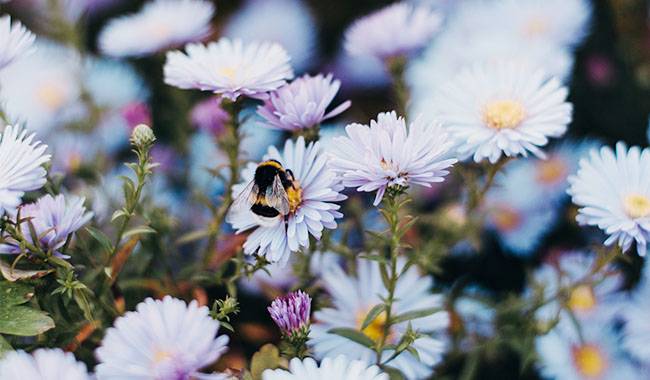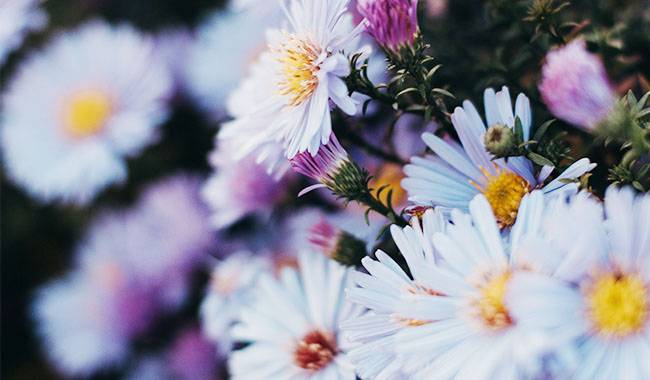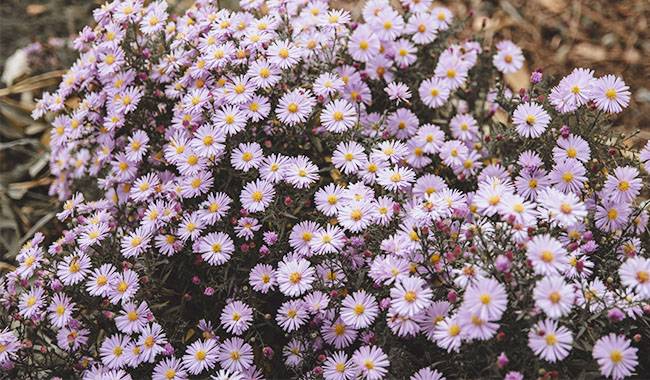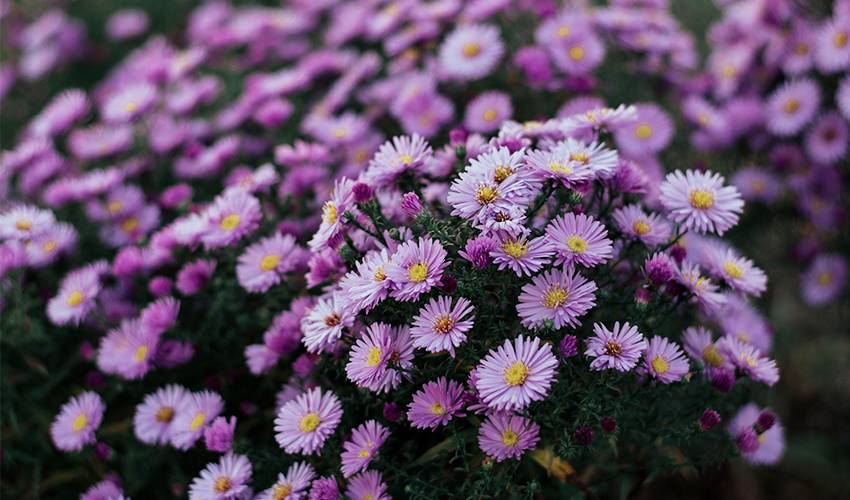
Autumn in the shady park… The gold of the maple tree lies on the water of the pond. The leaves are turning, the birds are silent… In the cold sky, it looks like there is an asteroid, a radiant asteroid.
Aster is a relatively unpretentious plant, but very sensitive to irrigation: excessive soil moisture and prolonged drought can cause damage.
Another weakness of Aster is its susceptibility to fungal diseases. Bacillus cereus, for example, can destroy Aster in just one day once it enters!
To prevent bacterial and viral diseases, the area under Aster should be initially “hardened”: splash it with boiling water or build a fire.
- What seeding techniques will protect your Aster from the insidious Fusarium?
- Why not store your favorite Aster seeds for a long time?
- How do chrysanthemums interact with marigolds and Aster?
- How to grow perennial Aster?
Let’s discuss it together.
ASTER PLANTING AND CARE
Planting: Early spring (March) or open field sowing under winter, or seedlings in late March. seedlings are set in April or May.
Flowering: Summer, autumn.
Light: Bright sun, semi-shade.
Soil: Fertile, loamy soil cultivated to a depth of 8inch (20cm).
Watering: Moderate. In hot weather, less often but more often.
Fertilizer: 3 times per season: after germination, during germination, and one week during early flowering.
Propagation: annuals by seed, perennials usually by vegetative propagation (bush divisions and cuttings).
Pests: salivary weevil, spider mite, leaf nematode, and gall nematode.
Diseases: powdery mildew, ringspot, gray flower rot, verticillium, and viral jaundice.
Aster (lat. Aster) – a genus of annual and perennial herbs of the Asteraceae family, or Asteraceae, with various numbers of views from 200 to 500 species, most of which grow in North and Central America.
In Europe, Aster was secretly introduced from China by a French monk in the 17th century. Aster means “star” in Latin.
There is a Chinese legend that two monks climbed the highest mountain in Altay for many days in order to reach the stars, but when they reached the top, the stars above were as far away and out of reach as they were in the sky.
Then, disappointed and without food or water, they spent many difficult days on the road and returned to the foot of the mountain to see a wonderful meadow with beautiful flowers in bloom.
“Look,” said a monk, “we are looking for the stars in the sky, and they are living on earth!” The monk dug up some flowers, brought them to the monastery, began to plant them, and gave them the star name “Aster”.
In China, from very early times, Aster has been a symbol of beauty, elegance, modesty, and charm. Aster is the flower of Virgo, a symbol of unknown dreams, a gift from God to man, his talisman, his guiding star ……
BOTANICAL DESCRIPTION
Aster – a rhizomatous plant with simple leaves, inflorescence – basket, gathered in panicles or shields, marginal flowers in which – ligulate of all possible colors, and central – tubular, small, almost always yellow.
Since the seventeenth century, since the cultivation of Aster flowers in Europe, scientists have successfully cultivated their cultivated varieties of stunning beauty, of which there are copies of various colors and shapes.
Aster is propagated by seeds. Depending on the quality of the inflorescence and the height of the stems, Aster can be used in borders, group plantings, pots, cradles, or as decoration for balconies and terraces. Very beautiful Aster is used in bouquets and can be kept for a long time.
GROWING ASTER FROM SEED
How to sow seeds
Grow Aster from seed, using both nursery and non-nursery methods. Aster flowers are sown in early to mid-March, and you can start seeing flowers in July. For later cultivars, sow in late April or early May when the temperature is at least 50°F (10°C). Note, however, that seedless Aster blooms later than those you start in the greenhouse.
Sow Aster in shallow furrows (no more than 1.6inch-4cm deep), water well, cover with soil, and in dry weather, mulch or cover the planting site with mulch until seedlings emerge.
Thereafter, mulching material should be used only in case of frost. When the seedlings have two to three true leaves, thin them out so that the spacing between seedlings is 4-6inch (10-15cm). Transplant the excess seedlings to other locations.
When to sow seeds
Early varieties of Aster bloom 90 days after planting, medium and early varieties – within 110 days (early August), late – within 120-130 days (late August – mid-September).
That means that before sowing Aster you need to do some simple calculations. Late varieties of Aster can bloom until frost.
Sow Aster not only in spring but also in late autumn, under winter, directly in furrows on the frozen ground – in this case, the plant is practically not damaged by Fusarium.
When sprouts appear in the spring, they are thinned out. By the way, do not forget that the seeds have a short shelf life: after two years of storage, the germination rate is reduced by half.
Growing seedlings
Growing Aster with seedlings requires a little more time and labor, but it is much more reliable than the seedless method. Depending on the variety, sow seedlings for seedlings in April or early May.
One week before sowing, wrap Aster seeds in cloth and soak them in a weak manganese solution. 10-12 hours later, squeeze out the excess water from the cloth, put them in a plastic bag, and put them in a warm place for germination. Aster seedlings can be grown in crates or pots as containers.
Aster’s soil should be light and fertile and be sure to water it with a fungicide solution before planting. Spot the seeds in a trench made in the ground, cover with 0.2inch (0.5cm) of sand, pour a weak manganese solution through a fine sieve, cover with glass or film and then place in a warm place 68-72 (20-22°C).
If you sow the seeds collected last year, they will already be ready to germinate in 3-5 days. After germination, move the container to a cold room at about 61°F (16°C). When the seedlings have 3-4 true leaves, prick them according to the 1.6 x 1.6inch (4 x 4cm) rule.
When picking, shorten the roots of the seedlings. Add ash to the transplanting soil and water moderately.
PLANTING ASTER

When to plant
One week after picking, feed the seedlings with a compound fertilizer solution and continue fertilizing once a week until planting in the open. Start to gradually adapt to the environment they are in: take them outdoors for a while, as hardened seedlings are better able to take root.
At planting time, your seedlings should have a sturdy stem up to 4inch (10cm) tall with 6-8 large green leaves. The best time to plant seedlings is around April or May.
Aster is hardy and does not tolerate nighttime temperatures dropping to 37-39°F (3-4°C). Aster grown out in the open is best in the evening.
How to plant
The first step in planting Aster is to select a site. The place for planting seedlings should be sunny and well-drained. the most favorable predecessors of Aster are Tagetes and Marigolds. Planting and maintaining Aster is best done on light, fertile, neutral soil.
The place where Aster stems will be planted should be prepared in advance: in autumn, dig deep on the proposed site with humus or compost at the rate of 2-4 kg per 1 m², and in spring, after digging, add 20-40 g of superphosphate, 15-20 g of potash and an equal amount of ammonium sulfate per m².
If the soil is not depleted, there is no need to apply fertilizer.
Before planting it is necessary to weed, level, and loosen the soil to a depth of 2-2.5inch (4-6 cm). Wetting is also desirable, especially if you buy seedlings in the store and don’t know how long the roots have been open.
Plant seedlings in shallow water-soaked trenches at least 8inch (20cm) apart from each other, but the distance depends on the Aster variety.
The distance between trenches is about 20inch (50 cm). The seedlings are covered with dry soil and do not need to be watered after sowing, only after 2-4 days. After a week or two, feed Aster with nitrogen fertilizer.
CARE OF ASTER IN THE GARDEN
How to care for Aster
Any experienced florist to the question “How to grow Aster?” will answer that it is easy. Aster is unpretentious and caring for them does not require much time and effort.
The first rule of Aster care is to loosen the soil and weed at the same time. This should be done after every rain or watering, at a depth of 2-2.5inch (4-6cm) and no more. Even before branching starts, stem dipping should be done at a height of 2-3inch (6-8cm) to accelerate root growth.
When watering Aster, remember that too little and too much water can harm Aster. In the hot summer months, water less frequently but in sufficient quantities (up to 3 buckets of water per 1 m2) and always hoe after watering. If you water too late, the inflorescence may lose its decorative character.
If you want to get the most out of your Aster, don’t forget to feed them. Fertilize at least three times during the season: the first time a week or two after planting (20 g ammonium nitrate, 10 g potassium sulfate, and 50 g superphosphate per square meter), the second time at flowering (50 g potassium sulfate and superphosphate per 1 square meter) and the third time at flowering (same composition).
Timely removal of dead flowers.
POSSIBLE PLANTING PROBLEMS
Sometimes the unassuming Aster can really make a grower nervous, especially if you decide to plant these little “stars” for the first time in your plot.
- Difficulties start with sowing: The seeds may not be threshed, or the seedlings may grow poorly and wilt. Resow immediately in order not to delay, but strictly observe all the agronomic requirements of the soil – the reason is in its composition or inadequate pre-sowing treatment.
- Annual Aster is affected by Fusarium. Do not plant Aster where monocotyledons (potatoes, tomatoes) or Leucaena, carnations, gladioli, tulips grew in previous years, at least five years, otherwise Aster will be exposed to the risk of fusarium; for the same reason, do not fertilize Aster with fresh manure.
- Aster’s inflorescence is incomplete – the plant may have suffered from aphids or spider mites, the rules of agronomy may have been broken, or the plant may not have received adequate nutrition.
DISEASES OF ASTER
Fusarium is the main disease of Aster and the most common one. There is no method to control Fusarium, so it is so important to follow preventive measures – crop rotation and plot rotation. aster is rotated with other plants and will not be reintroduced to the plot in as little as 5 years. Diseased plants should be removed and burned to prevent the spread of the pest to other plants and plots.
Another fungal disease that affects Aster is the blackleg, which manifests itself as the blackening of seedlings and the decay of the root neck and stem base. The pathogen develops on acidic soils. The fungus can be controlled by removing diseased plants, disinfecting the soil with a 1% manganese solution, and sprinkling the soil around the plants with sand.
Aster rust is a disease – the underside of the leaves appear swollen with spores and the leaves wilt and dry out. Plant Aster plants away from conifers (conifers are where rust spores enter Aster plants) and as a preventative measure, spray Aster with a 1% solution of Bordeaux mixture and repeat this weekly if the disease is already present.
Aster jaundice is another disease that affects Aster and is caused by a virus carried by aphids or cicadas. It starts with a lightening of the leaf layer, followed by a general wilting of the leaves and inhibition of growth, including the flower buds, which take on a greenish tinge.
To eliminate the vector, Aster needs to be sprayed with insecticide and the affected plant specimens removed and burned.
Powdery mildew, Verticillium – the “all-purpose fungicide”: Metronidazole copes well with these diseases.
PESTS OF CHRYSANTHEMUM
In terms of insect pests, the threats are the grass worm, mouthwatering warbler, plowshare, common earwig, spider mite, kidney aphid, moth, etc.
As preventive measures, we recommend that you.
- Thoroughly dig the soil in the garden in autumn.
- removal and obligatory burning of shoots of annuals and perennials withered by autumn; correct practice in the selection of garden plant species.
- Improve the soil by liming and introducing humus and compost.
- Maintain proper plant spacing to avoid weakening and elongation of plants due to forced crowding.
If pests still appear, you need to use pesticides or folk remedies to control them.
PHALAENOPSIS NO LONGER BLOOMS – WHAT TO DO?
Post-flowering care
After the garden (annual) Aster blooms it is best to dig it up and burn it to kill any viruses, fungi, and pests that may have settled in it.
If you have collected seeds of the variety you want to plant next year, you can sow them into the soil after the first frost, but in a different area of the garden. Sow the seeds in a furrow and cover them with peat or humus.
Winter sowing can be done in December and January in the snow.
To do this, make trenches directly into the snow that has been pressed in first and cover the seeds with peat. Sowing in the snow is more reliable because then the seeds are not afraid of a sudden thaw. In spring, after the snow has melted, cover with cling film to speed up the germination of the seeds.
How to collect Aster seeds: wait until the inflorescence of your favorite variety has withered, the center of the inflorescence has darkened and a white fuzz has appeared, pick the inflorescence, put it in a paper bag, and continue drying.
Sign the bag so as not to confuse the varieties. And remember: it is better to sow last year’s seeds in seedlings or in the ground because after two years the seeds will dramatically lose their germination capacity.
HOW TO PRESERVE ASTER IN WINTER
Perennial Aster can grow on the same plot for up to five years, so autumn is the right time to dig up and replant perennial Aster that has reached five years of age, especially since Aster has a high capacity for propagation by division. Pay attention to the root system – be careful not to damage it.
Perennial Aster is frost-tolerant, so their wintering in the open is not a particular concern for florists. However, some species are best wintered with peat, dried leaves, or green wood mulch for young plants.
If the Aster stems have dried out, it is best to cut them off before mulching. In the spring, uncover and let your Aster grow as soon as possible to decorate your garden with their extraordinary flowers.
The Twilight Zone is coming. The sky is rippling with the light of constellations, thin and sharp. Aster in the flowerbeds, fragrant and variegated, watching their sisters shine in the distance, greeting them from the earth.






